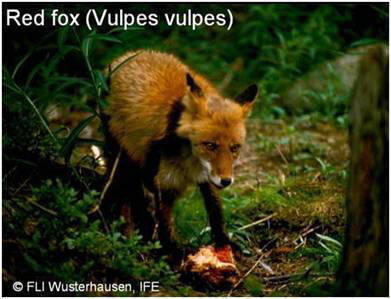Epidemiology
Besides some isolated countries that are regarded rabies free classical rabies
caused by
RABV
occurs worldwide. The disease is transmitted by rabid animals. Carnivors,
especially of the canidae family represent the principal reservoir
species and are responsible for the maintenance of the infectious cycle and
hence for the presence of the disease. In the Americas, bat species are also
reservoir for RABV.
(See
Rabies and Bats)
 Wildlife
rabies
is characterized by the establishment of transmission cycles in one or more
carnivorous wildlife species. For example, in Europe the red fox (Vulpes
vulpes) is the main reservoir species. In parts of Asia the racoon dog (Nyctereutes
procyonoides) is also considered reservoir species for rabies. In Eastern
Europe, introduced raccoon dogs may be implicated in sustaining the chain of
infection, too. In the Americas, bat species are also reservoir for RABV.
Wildlife
rabies
is characterized by the establishment of transmission cycles in one or more
carnivorous wildlife species. For example, in Europe the red fox (Vulpes
vulpes) is the main reservoir species. In parts of Asia the racoon dog (Nyctereutes
procyonoides) is also considered reservoir species for rabies. In Eastern
Europe, introduced raccoon dogs may be implicated in sustaining the chain of
infection, too. In the Americas, bat species are also reservoir for RABV.
Within one geographic region different infection cycles may occur
simultaneously, as in the Americas where independent rabies infectious cycles in
raccoons (Procyon lotor), skunks (Memphetis ssp), red foxes (Vulpes
vulpes), grey foxes (Urocyon cinereoargenteus), coyotes (Canis
latrans) and arctic foxes (Alopex lagopus) exist. Wildlife rabies is
sporadically transmitted to domestic animals and to
humans.
 Canine
rabies
is by far more important for public health and contributes to 99% to the human
death toll. Dogs maintain and transmit the disease through bite inflictions,
causing more than 50.000 human casualties annually. Mainly developing countries
from Asia and Africa suffer from the burden of the disease. The WHO regards
rabies as a neglected disease and efforts are promoted to establish wider access
to appropriate post-exposure treatment for humans.
Dog rabies control
by
mass vaccination campaigns and dog population management are supported and are
the only way to control the disease.
Canine
rabies
is by far more important for public health and contributes to 99% to the human
death toll. Dogs maintain and transmit the disease through bite inflictions,
causing more than 50.000 human casualties annually. Mainly developing countries
from Asia and Africa suffer from the burden of the disease. The WHO regards
rabies as a neglected disease and efforts are promoted to establish wider access
to appropriate post-exposure treatment for humans.
Dog rabies control
by
mass vaccination campaigns and dog population management are supported and are
the only way to control the disease.